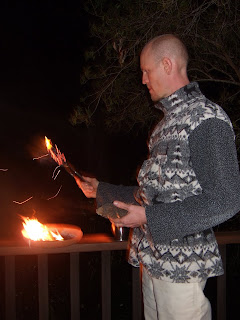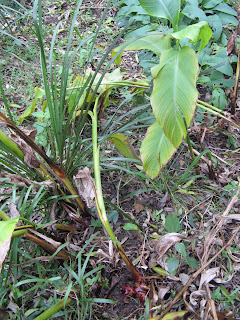
CRYSTAL WATERS
PERMACULTURE VILLAGE
July 7th to July 28th
(my last WWOOF place of my 6 month stay in Australia)
 On July 7th I took the train for $9 from Brisbane north about 2 hours to Landsborough. I then hitched, getting 2 different rides, the 15 miles west to Maleny and then on to Crystal Waters.
On July 7th I took the train for $9 from Brisbane north about 2 hours to Landsborough. I then hitched, getting 2 different rides, the 15 miles west to Maleny and then on to Crystal Waters.
Crystal Waters is a 640 acre intentional community established in 1987 and based on ecological design with privately owned land as well as communal land. There are about 83 residential lots and at least 200 people who live in Crystal Waters Village.
While at Crystal Waters - wow - I was here at Crystal Waters for 3 weeks - I met lots of people, lots of beautiful, kind, and accepting people, but I stayed with 2 of the best - with Scott and Kylie at their house and business called WATERBREATH RETREAT.
www.waterbreath.com
BAMBOO FOREST at Crystal Waters
This bamboo forest is absolutely amazing - a beautiful place to walk around - and also one of the businesses at Crystal Waters - selling bamboo for timber.





 Bamboo grows different ways - there are the kinds that grow in clumps, and the kind that runs. The kind that runs as it grows will run rampant and take over everything, which is why people are hesitant to plant bamboo. Crystal Waters has both kinds and what I thought was really interesting is how they handled these 2 kinds of bamboo - they use the river to stop the growth of the running bamboo in one direction, and the clumping bamboo to stop the growth of the running bamboo in the other direction - so the clumping bamboo is used to "fence" or "herd" the other bamboo. I thought this was really great.
Bamboo grows different ways - there are the kinds that grow in clumps, and the kind that runs. The kind that runs as it grows will run rampant and take over everything, which is why people are hesitant to plant bamboo. Crystal Waters has both kinds and what I thought was really interesting is how they handled these 2 kinds of bamboo - they use the river to stop the growth of the running bamboo in one direction, and the clumping bamboo to stop the growth of the running bamboo in the other direction - so the clumping bamboo is used to "fence" or "herd" the other bamboo. I thought this was really great.


Kylie and I go to a local mushroom farm to pick up some mushroom compost to put on her garden. This mushroom compost is the spent substrate that the mushrooms were growing in and it makes a rich compost. We even gather a few handfuls of mushrooms to eat for dinner.



The mushroom farm buildings in the background - I noticed that they have mugwort growing around the perimeter of the buildings. I made a comment about this and the guy said mugwort is good for insect deterrent.

GREVILLEA FLOWER at Waterbreath Retreat
This flower belongs to a diverse genus of about 360 species of evergreen flowering plants in the protea family. Proteaceae are native to Australia, New Guinea, New Caledonia and Sulawesi.
I am pretty sure this particular flower is a GREVILLEA BANKSII and this flower is endemic to Australia, meaning found only in Australia.
details from Wikipedia

GREVILLEA at Sunset at Waterbreath Retreat
 Crystal Waters used to have a huge farm, but now has 3 cows that the "farm brigade" as they call themselves, milks - and I made homemade cheese a couple of times for Scott and Kylie. Here is one of our morning teas with homemade cheese and hummus that I made along with these yummy star fruits from the tree outside and Kylie's favorite seaweed treats.
Crystal Waters used to have a huge farm, but now has 3 cows that the "farm brigade" as they call themselves, milks - and I made homemade cheese a couple of times for Scott and Kylie. Here is one of our morning teas with homemade cheese and hummus that I made along with these yummy star fruits from the tree outside and Kylie's favorite seaweed treats.

CANDLENUT TREE


The Candlenut (Aleurites moluccana), is a tree in the family Euphorbiaceae, also known as Candleberry, Indian walnut, Kemiri, Varnish tree or Kukui nut tree.
Its native range is impossible to establish precisely because of early spread by humans, and the tree is now widely distributed in the New and Old World tropics. It grows to a height of 15-25 m, with wide spreading or pendulous branches. The leaves are pale green, simple and ovate, or trilobed or rarely 5-lobed, with an acute apex, 10–20 cm long. The nut is round, 4–6 cm in diameter; the seed inside has a very hard seed coat and a high oil content, which allows its use as a candle, hence its name.
details from Wikipedia









I gathered some candlenuts and roasted them in Scott and Kylie's fire - the nuts were very good eaten this way.




The nuts do have a high oil content and I just had to see if one would burn - it did and I think would make a great crude candle.

When I was reading about the candlenut, I read that the raw nuts could be ground into a paste and used as shampoo so I had to try this as well:




PERMACULTURE VILLAGE
July 7th to July 28th
(my last WWOOF place of my 6 month stay in Australia)
 On July 7th I took the train for $9 from Brisbane north about 2 hours to Landsborough. I then hitched, getting 2 different rides, the 15 miles west to Maleny and then on to Crystal Waters.
On July 7th I took the train for $9 from Brisbane north about 2 hours to Landsborough. I then hitched, getting 2 different rides, the 15 miles west to Maleny and then on to Crystal Waters.Crystal Waters is a 640 acre intentional community established in 1987 and based on ecological design with privately owned land as well as communal land. There are about 83 residential lots and at least 200 people who live in Crystal Waters Village.
While at Crystal Waters - wow - I was here at Crystal Waters for 3 weeks - I met lots of people, lots of beautiful, kind, and accepting people, but I stayed with 2 of the best - with Scott and Kylie at their house and business called WATERBREATH RETREAT.
www.waterbreath.com
BAMBOO FOREST at Crystal Waters
This bamboo forest is absolutely amazing - a beautiful place to walk around - and also one of the businesses at Crystal Waters - selling bamboo for timber.





 Bamboo grows different ways - there are the kinds that grow in clumps, and the kind that runs. The kind that runs as it grows will run rampant and take over everything, which is why people are hesitant to plant bamboo. Crystal Waters has both kinds and what I thought was really interesting is how they handled these 2 kinds of bamboo - they use the river to stop the growth of the running bamboo in one direction, and the clumping bamboo to stop the growth of the running bamboo in the other direction - so the clumping bamboo is used to "fence" or "herd" the other bamboo. I thought this was really great.
Bamboo grows different ways - there are the kinds that grow in clumps, and the kind that runs. The kind that runs as it grows will run rampant and take over everything, which is why people are hesitant to plant bamboo. Crystal Waters has both kinds and what I thought was really interesting is how they handled these 2 kinds of bamboo - they use the river to stop the growth of the running bamboo in one direction, and the clumping bamboo to stop the growth of the running bamboo in the other direction - so the clumping bamboo is used to "fence" or "herd" the other bamboo. I thought this was really great.

Kylie and I go to a local mushroom farm to pick up some mushroom compost to put on her garden. This mushroom compost is the spent substrate that the mushrooms were growing in and it makes a rich compost. We even gather a few handfuls of mushrooms to eat for dinner.



The mushroom farm buildings in the background - I noticed that they have mugwort growing around the perimeter of the buildings. I made a comment about this and the guy said mugwort is good for insect deterrent.

GREVILLEA FLOWER at Waterbreath Retreat
This flower belongs to a diverse genus of about 360 species of evergreen flowering plants in the protea family. Proteaceae are native to Australia, New Guinea, New Caledonia and Sulawesi.
I am pretty sure this particular flower is a GREVILLEA BANKSII and this flower is endemic to Australia, meaning found only in Australia.
details from Wikipedia

GREVILLEA at Sunset at Waterbreath Retreat
 Crystal Waters used to have a huge farm, but now has 3 cows that the "farm brigade" as they call themselves, milks - and I made homemade cheese a couple of times for Scott and Kylie. Here is one of our morning teas with homemade cheese and hummus that I made along with these yummy star fruits from the tree outside and Kylie's favorite seaweed treats.
Crystal Waters used to have a huge farm, but now has 3 cows that the "farm brigade" as they call themselves, milks - and I made homemade cheese a couple of times for Scott and Kylie. Here is one of our morning teas with homemade cheese and hummus that I made along with these yummy star fruits from the tree outside and Kylie's favorite seaweed treats.
CANDLENUT TREE


The Candlenut (Aleurites moluccana), is a tree in the family Euphorbiaceae, also known as Candleberry, Indian walnut, Kemiri, Varnish tree or Kukui nut tree.
Its native range is impossible to establish precisely because of early spread by humans, and the tree is now widely distributed in the New and Old World tropics. It grows to a height of 15-25 m, with wide spreading or pendulous branches. The leaves are pale green, simple and ovate, or trilobed or rarely 5-lobed, with an acute apex, 10–20 cm long. The nut is round, 4–6 cm in diameter; the seed inside has a very hard seed coat and a high oil content, which allows its use as a candle, hence its name.
details from Wikipedia









I gathered some candlenuts and roasted them in Scott and Kylie's fire - the nuts were very good eaten this way.




The nuts do have a high oil content and I just had to see if one would burn - it did and I think would make a great crude candle.

When I was reading about the candlenut, I read that the raw nuts could be ground into a paste and used as shampoo so I had to try this as well:




CANDLENUT PASTE SHAMPOO/LOTION
I tried this as a shampo and it did work - see the oil on my hand from the nut-paste - it also worked as a lotion.
I tried this as a shampo and it did work - see the oil on my hand from the nut-paste - it also worked as a lotion.
Scott and Kylie have some great book and this is one that I really liked looking at - it talked about the native foods of this area in Queensland - especially the BUNYA PINE NUT.
BUNYA NUT TREE

The BUNYA TREE produces nuts that come to a maturity every 3 years. I saw bunya nut trees with cones, but they were not mature. I would love to have found and harvested the pine nuts from one of these massive cones!
Gordon, one of the Crystal Waters Community members, makes his own very yummy beer (I helped with the bottling one Sunday) and also he grows his own wheatgrass and drinks it every morning - this is his setup to keep the possums out:

WILD GINGER growing right outside my room where I stayed at Waterbreath Retreat.
I found this slug while I was working in the yard and while I am not sure what kind of slug he is, I named him
RANDY THE RAINFOREST SLUG
RANDY THE RAINFOREST SLUG

Scott and Kylie have a lemon tree outside that was loaded with lemons. Here I am making lemon pickle, an indian condiment with lots of spices. It cures in the sun and softens and is ready to use in a few months. I also used leaves from the nearby kaffir lime tree.



greens from the garden that I juiced and drank - yum

I saw so many interesting creatures in this rainforest environment - a grass tree snake up in a papaya tree, lots of interesting honey eater birds, a massive snake that had just eaten a possum or other animal and lots of strange bugs and other creepy crawlers.

Scott Dunbar is a musician and makes slide-didgeridoos:
www.slidedidge.com
This instrument below is not a slide-didge, but another instrument that Scott made that I absolutley love!
www.slidedidge.com
This instrument below is not a slide-didge, but another instrument that Scott made that I absolutley love!

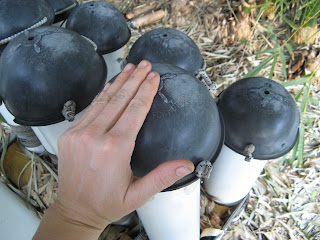
Here I made a bread from a recipe that I found at Luc Van DeGoors in Taliem Bend in May, a bread called PIONEER BREAD that uses lemon juice instead of yeast.

PIONEER BREAD and 2 different kinds of DAMPER bread - a traditional Australian bread. One of the damper breads I used a wild herb that I found outside called FIVE HERB - a plant with thick fuzzy leaves and smells a bit like oregano.

Cobbler's Peg - a weed that is everywhere here, but that is also edible. It is also called Farmer's Friend. I met this weed when I was staying in Kyogle working pulling weeds in Richard's mulberry grove - these nasty little pitchfork seeds covered me and were embedded into my sweater - it took about a week to pick out all of the seeds.


Another weed in this area, a blue flower that can be used as a tea, but not for daily drinking. I have not researched any more about this plant yet.



LEMON MYRTLE leaves from the bushes outside at Scott and Kylie's place. We made lots of lemon Myrtle tea.

PUMPKIN BREAD





Waterbreath Retreat - papaya, or paw-paw tree and a clump of what I hear is called FIVE HERB, a weed apparently, but also edible. I used it it in cooking, but have not researched much about this plant yet.




MAKING QUICHE
I used the eggs from the chooks outside, the potatoes that I gathered from a throw-away bin behind a shop and some pumpkin from the garden, mushrooms gleaned from the mushroom compost, and some of the five herb weed outside.

I used the gleaned potatoes to make a potato crust for the quiche - grated and pressed into the pan and then baked for just a bit before adding the egg and other ingredients.



ABUNDANCE



ABUNDANCE

Most of this bounty is from the garden outside, from the trees, grown in the garden, produced by the chickens, gathered from the wild, and made by us.
GLASS HOUSE MOUNTAINS

Scott offered to take us mountain climbing and that is just what we did,
WE CLIMBED A MOUNTAIN!
Scott drove us to the Glass House Mountains a bit south of Maleny maybe 30k or so, about 40 minutes south. This area is a flay plain punctuated by extinct volcanoes that formed 25 to 27 million years ago. They are called the glasshouse mountains because the explorer that named them was reminded of the huge glass furnaces back in his native Yorkshire.
We were going to climb Mt Beerwah, the highest of the peaks at 555 metres (1824 feet), but it was closed due to a rock slide.
WE CLIMBED A MOUNTAIN!
Scott drove us to the Glass House Mountains a bit south of Maleny maybe 30k or so, about 40 minutes south. This area is a flay plain punctuated by extinct volcanoes that formed 25 to 27 million years ago. They are called the glasshouse mountains because the explorer that named them was reminded of the huge glass furnaces back in his native Yorkshire.
We were going to climb Mt Beerwah, the highest of the peaks at 555 metres (1824 feet), but it was closed due to a rock slide.



This, the pointy rocky tip in the above photo, is Mt Coonowrin, the 2nd highest mountain at 377 metres. It is presently illegal to climb due to it unstable composition especially near the summit.
This is the mountain that we climbed! It is called MT TIBROGARGAN and is the third highest mountain here at 364 metres (1194 feet).
This is the mountain that we climbed! It is called MT TIBROGARGAN and is the third highest mountain here at 364 metres (1194 feet).

CLIMBING TIBROGARGAN
This was a steep climb and many parts of this trek made me very very uncomfortable.
This was a steep climb and many parts of this trek made me very very uncomfortable.
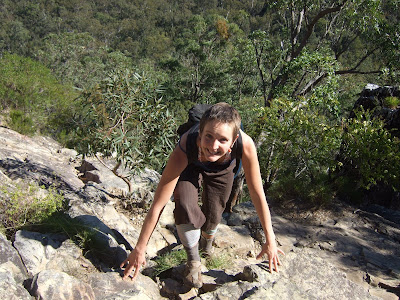
One of the views from partway up - the trees planted in the distance are all in rows - a timber plantation.

At the TOP! This was not that long of a climb, about 3 hours, but boy was I ready to sit for awhile. While at the top our view was out across the plain and across the pineapple fields and macadamia tree farms.



pineapple fields and macadamia nut trees


Scott was a great guide! He made me feel like I could do anything! Thank you for taking us on this climb Scott!



At the bottom they were harvesting pineapples in this field and as it grows dark here is the shape at dusk of the mountain that we climbed.

Crystal Waters Bakery
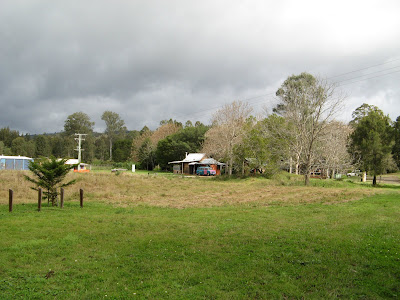

Mayuko and I help them make bread one Friday - in time for the Crystal Waters market on Saturday morning.


This is Les - the king of the breadmaking and he was so fun to talk to. There was definitely an art to the shaping of this bread - push and pull and roll and pinch with just the right amount of flour - they made it looks so easy, but it was harder than it looked.





Flour on my shoes after helping in the bakery.

Mayuko and I helped Annie package chai - she makes the most beautiful tasting chai tea at Crystal Waters and sells it at the market as well as in shops.


I made cheese a couple of times from the milk that Scott got after helping to milk the Crystal Waters cows.





A painted face wallaby and her baby outside my room at Crystal Waters.


Mayuko's GUMBOOTS - I love them and want to get a pair

collecting from the garden




making LIME PICKLE from the fruits in the garden

making LIME CURD from the kaffir limes outside


Mayuko called this plant MOON PEACH as it is what it is known as in Japan. It is also called CARDAMON GINGER / alpina calcarata.
I saw this plant also in Brazil and now I finally get to use it. Richard also had it on his farm in Kyogle. As far as I know it is not edible, but the leaves impart a wonderful cardamon-like flavor to anything that it is in contact with. I had heard about wrapping this leaf around fish or steaming rice inside the wrapped leaves.
I saw this plant also in Brazil and now I finally get to use it. Richard also had it on his farm in Kyogle. As far as I know it is not edible, but the leaves impart a wonderful cardamon-like flavor to anything that it is in contact with. I had heard about wrapping this leaf around fish or steaming rice inside the wrapped leaves.
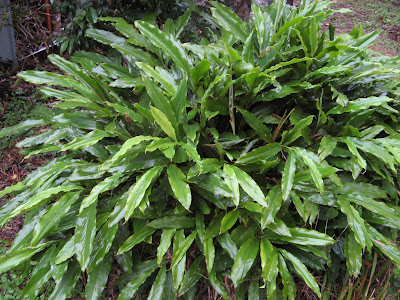
Mayuko knew that I was interested in this plant and she made a traditional Japanese sweet for us and it was SO GOOD! She used rice and passionfruit (from the vines outside) and tapioca, and steamed these little bundles in a basket on the stove.

Gathering DOCK for a steamed vegetable...

I absolutely loved taking care of Scott and Kylie's chooks, or as Kylie and I called them, THE GIRLS! I herded them from one pen to another 2 times a day usually - just used a long pvc pipe to get them going and keep them headed in the right direction - as long as I let the ducks lead, or one duck in particular, it was all ok and they waddled in a path like some strange circus coming to town.

 I think there was a Barbara and Brenda maybe....can't remember exactly their names, but they did all have their own personality....it was one of the black ones, Barbara I think, that always straggled in line and preferred to scratch the leaves onto the path in this one particular corner every time we headed to the other pen - she was also the one who seemed to wiggle her way out of the pen first when she was not supposed to.
I think there was a Barbara and Brenda maybe....can't remember exactly their names, but they did all have their own personality....it was one of the black ones, Barbara I think, that always straggled in line and preferred to scratch the leaves onto the path in this one particular corner every time we headed to the other pen - she was also the one who seemed to wiggle her way out of the pen first when she was not supposed to.BIG SNAKE
that I saw just near my bedroom - and this snake was large, at least 2.5 metres long, and had just eaten something too as the belly was all lumpy - Kylie told me to go and sit by it and she would take my photo - I just laughed at her, but did it anyway - Kylie was right, it did not even move or twitch - must have been too full and was busy using all energy to digest that possum-meal. I have never seen a snake this large in the wild and it was amazing. I want to ask Sonia what kind of beautiful snake this is.
that I saw just near my bedroom - and this snake was large, at least 2.5 metres long, and had just eaten something too as the belly was all lumpy - Kylie told me to go and sit by it and she would take my photo - I just laughed at her, but did it anyway - Kylie was right, it did not even move or twitch - must have been too full and was busy using all energy to digest that possum-meal. I have never seen a snake this large in the wild and it was amazing. I want to ask Sonia what kind of beautiful snake this is.


CANNA INDICA
family / cannacea
genus / canna
aka INDIAN SHOT
The root is edible cooked. "Canna Starch" is used as an arrowroot - obtained by rasping the root into a pulp then washing and straining to get rid of the fibers. The fiber (from the stem?) is used as a jute substitute and the fiber from the leaves is used for paper. To make paper harvest in the late summer after the plant has flowered - scrape to remove the outer skin, then soak in water for 2 hours prior to cooking. Cook the fibers for 24 hours with lye and beat in blender. In addition the seed makes a purple dye. I was excited to read that this plant, a plant that I have seen in many flower beds in America, has so many uses.
family / cannacea
genus / canna
aka INDIAN SHOT
The root is edible cooked. "Canna Starch" is used as an arrowroot - obtained by rasping the root into a pulp then washing and straining to get rid of the fibers. The fiber (from the stem?) is used as a jute substitute and the fiber from the leaves is used for paper. To make paper harvest in the late summer after the plant has flowered - scrape to remove the outer skin, then soak in water for 2 hours prior to cooking. Cook the fibers for 24 hours with lye and beat in blender. In addition the seed makes a purple dye. I was excited to read that this plant, a plant that I have seen in many flower beds in America, has so many uses.



Kylie sliced the root, tossed with rosemary and oil and salt and pepper and put them in a hot wok - they made wonderful thick-potato chip like slices!

Lyle had some of these magazines that I loved, and Scott and Kylie have a big stack of them too - I looked through each one of them. I love the cover of this one - this guy has a big red cup just like mine!

My last bit of stay in Australia was with STEVE THOMPSON - a sweet and very funny guy who lived at Crystal Waters - I met him at Crystal Waters, we started talking about sculpture, and he mentioned that he would love to talk shop, specifically ceramics. So I went to Brisbane and stayed with Steve and his crew of crazies at his house - I saw a new part of Brisbane - got to see Mel Robson's show that she now had up downtown, and just loved being with Steve, his son Scottie and all of Steve's friends and family. We went out, talked about art, argued, went to the museums, went out on a boat taxi in the river in Brisbane, and just had a grand time. I did not do much work in my opinion, but felt taken care of - a nice transition and space to reflect on my time in Australia. We also made a trek back to Crystal Waters to hike in the river looking for wood to make a sculpture out of - a commission that Steve had in the works. And we also went to see Stacy - the woman who picked me up when I was hitching on my way into Crystal Waters! So everything came full circle! I met so many people at Crystal Waters and was there long enough, 3-4 weeks, to feel like I belonged, a gentle addition to the intentional community at Crystal Waters - it was amazing how all the people were woven together and how I wove in and out of it all. Such a great flow of energy!
WOW!
Steve's roommate Francis, from Belgium, was a beautiful guy. He made this instrument that I really liked - very simple and sounded good too. I want to make one or maybe several.
WOW!
Steve's roommate Francis, from Belgium, was a beautiful guy. He made this instrument that I really liked - very simple and sounded good too. I want to make one or maybe several.




A brief stay back at Crystal Waters, a river walk, the Saturday market, party and homebrew at Gordon's. And a big teary hug for Scott and Kylie in the middle of the Crystal Waters road! This is the solar oven at Gordon's, and my dandelion tea while I crack macadamia nuts for the bus trip back to Sydney...
a 12 hour bus trip from Brisbane to Sydney and a 16 hour flight from Sydney to the USA, San Francisco.
By the way, Scott, while I was on the bus ride from Brisbane to Sydney, I made a thin cord/rope from my sisal fibers that I harvested on Kangaroo Island and used it to wear my new banksia cone pendant that you made for me! Perfect! Thank you!
a 12 hour bus trip from Brisbane to Sydney and a 16 hour flight from Sydney to the USA, San Francisco.
By the way, Scott, while I was on the bus ride from Brisbane to Sydney, I made a thin cord/rope from my sisal fibers that I harvested on Kangaroo Island and used it to wear my new banksia cone pendant that you made for me! Perfect! Thank you!

THE END
My WWOOF book at the end of my 6 month journey in Australia.
February 4th to August 4th, 2008
The WWOOF program is really amazing - a great way to travel and work in trade for food and a place to sleep - a way to meet genuine people living real lives - and being able to be a part of it for a bit.
Thank you WWOOF AUSTRALIA - http://wwoof.com.au/
WILLING WORKERS ON ORGANIC FARMS
My WWOOF book at the end of my 6 month journey in Australia.
February 4th to August 4th, 2008
The WWOOF program is really amazing - a great way to travel and work in trade for food and a place to sleep - a way to meet genuine people living real lives - and being able to be a part of it for a bit.
Thank you WWOOF AUSTRALIA - http://wwoof.com.au/
WILLING WORKERS ON ORGANIC FARMS






Steve buys me some roadside strawberries for the bus trip - YUM!

THANK YOU SO MUCH TO ALL MY NEW FRIENDS!









